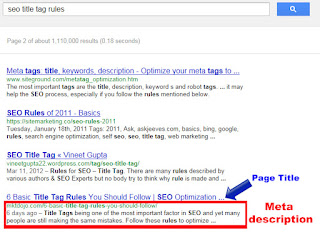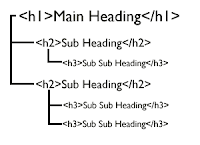Onpage Optimization is a sub-class of SEO
Execution of optimization techniques on the website itself are called as Onpage optimization. A well Onpage optimized website can not only rank higher in the search results but also can increase the readability of the website for the readers.
There are different factors on website which can be effect the ranking of that website. So with respect to those different factors there are different type of Onpage optimization techniques.They are listed below,
1)Title tag optimization
 Title tag is one of the most important element. Because title tag is the first thing indexed by the search engine. The title tag should be attractive,short and descriptive enough to identify the content of the page by the visitors. Title tag should contain the keyword on which we are concentrating. Length of the title tag should be with in the limits 55-60 characters and 512 pixels.
Title tag is one of the most important element. Because title tag is the first thing indexed by the search engine. The title tag should be attractive,short and descriptive enough to identify the content of the page by the visitors. Title tag should contain the keyword on which we are concentrating. Length of the title tag should be with in the limits 55-60 characters and 512 pixels.2)Meta description
 A site’s Meta description should contain a brief description about the website. And should mention the services of your company. This meta description act as a snippet, if a user finds it good he will click on the link and find out more information. But if your Meta
Description is too short or too large and is not written correctly then there is a chance for ignoring your site by the users. Meta description should be within 155-160 characters and should not exceed 1024 pixels
A site’s Meta description should contain a brief description about the website. And should mention the services of your company. This meta description act as a snippet, if a user finds it good he will click on the link and find out more information. But if your Meta
Description is too short or too large and is not written correctly then there is a chance for ignoring your site by the users. Meta description should be within 155-160 characters and should not exceed 1024 pixels3)Body tags
 while writing the content, should type the contents in paragraph with different subtitles it will be flexible for the reader to read the content. For the subtitles, we can use H1, H2,H3, H4, tags.
while writing the content, should type the contents in paragraph with different subtitles it will be flexible for the reader to read the content. For the subtitles, we can use H1, H2,H3, H4, tags.4)Optimization of keyword
 Website's content should optimized in such a way that it should be suitable for both search engines and readers. Stuffing too many keywords can make your site unreadable. Decide which keyword should be optimized, only after researching on that. Maintain optimum keyword density.
Website's content should optimized in such a way that it should be suitable for both search engines and readers. Stuffing too many keywords can make your site unreadable. Decide which keyword should be optimized, only after researching on that. Maintain optimum keyword density. 5)Optimization of links
 Link optimization is very important. It will give a good experience for the users. They can use the link if they have any doubts on that particular word or sentence. But do not add so many links, it will considered as link spamming.
Link optimization is very important. It will give a good experience for the users. They can use the link if they have any doubts on that particular word or sentence. But do not add so many links, it will considered as link spamming.
6)Image optimization
 If the site has lot of images, they should be optimized since search engines are not able to read the images. Search Engine spiders can only read text but not images. So we need to do some optimization techniques. Add ALT text, it describes the image when mouse moves over the image on the web page. While saving the file from internet use meaningful name. If we want to add a link for the image, use the image keywords.
If the site has lot of images, they should be optimized since search engines are not able to read the images. Search Engine spiders can only read text but not images. So we need to do some optimization techniques. Add ALT text, it describes the image when mouse moves over the image on the web page. While saving the file from internet use meaningful name. If we want to add a link for the image, use the image keywords.



